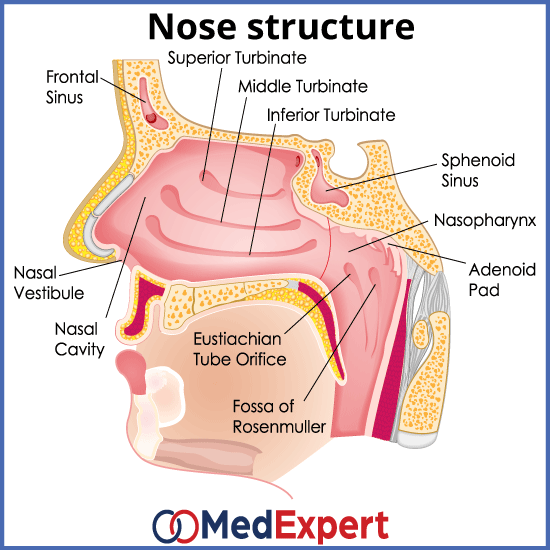TURBINATE HYPERTROPHY
Continuous nasal congestion, endless mucus draining from your nose… We all know how unpleasant and exhausting this condition is. Meanwhile, the reason for this may not lie in the runny nose or cold themselves. Turbinate hypertrophy is one of the factors, which cause continuous nasal congestion. Turbinate hypertrophy symptoms are similar to chronic or allergic rhinitis. Turbinate hypertrophy treatment depends on the cause of this condition and may include both, conservative and surgical options. Below you will find more information about this condition, its symptoms, as well as treatment options and diagnostic services.
The nasal turbinates are spongy bone structures that protrude into the nasal passages to direct airflow within the nose. There are three turbinates; the inferior, middle, and superior turbinate, on both sides of the nasal septum.

The turbinates are covered by respiratory epithelium, a specific type of tissue which help to clean and humidify the air as it passes through the nose. The epithelium also works as an immunological defense barrier in the presence of a microbial or chemical irritant, making the cells trigger an immune response that lead to inflammation.
WHAT CAUSES TURBINATE HYPERTROPHY?
The tissue lining of each turbinate maintains a lot of blood vessels. These blood vessels allow the turbinates to swell and shrink while the nasal cycle is ongoing. The swelling is usually caused by triggers such as chemical irritants, allergies, infections or temperature changes; these triggers cause the turbinate to expand. The expansion is usually temporary and reduces on its own but in some cases, they become dangerously enlarged leading to turbinate hypertrophy.
TURBINATE HYPERTROPHY SYMPTOMS
The symptoms of turbinate hypertrophy include:
- Difficulty in breathing through one or both noses
- Chronic sinus infections
- Snoring
- Frequent nosebleeds
TURBINATE HYPERTROPHY TREATMENT OPTIONS
- Antihistamines and Immunotherapy (Allergy Shots): This helps in reducing the frequency and severity of the body’s immune response including the swelling of the turbinate when allergies are the trigger.
- Nasal Steroid Sprays: This reduces turbinate inflammation and improves breathing.
- Surgical Turbinate Reduction: The surgical intervention is performed when the abovementioned treatment options turn out to be not effective. This surgery aims to make the turbinates smaller thereby opening the nasal airways. The procedure can be done with the help of several different surgical methods. Some techniques are based on removal of a part of the bone structure, while others attempt to shrink the tissue of the turbinates. In some cases, where there is a complex problem of a complicated condition the turbinate surgery can be performed together with septum surgery or sinus surgery.

DIAGNOSING TURBINATE HYPERTROPHY
- Physical examination: Questions about symptoms are asked by the doctor followed by an examination of the nose with the use of a nasal speculum which is designed to widen the nostrils.
- Nasal endoscopy: Nasoendoscopy is a minimally invasive, medical procedure carried out to diagnose any nasal conditions. It helps to examine the interior surfaces of the nose and allows visualization of its cavities not possible by standard examination. The procedure is performed with the help of a nasal endoscope which is a medical device consisting of a thin, rigid tube with fiberoptic cables to light-up the inside of the nose. The endoscope is then connected to a light source and a video camera to project magnified images on a screen. During the procedure your doctor may capture or record the images for further documentation.


